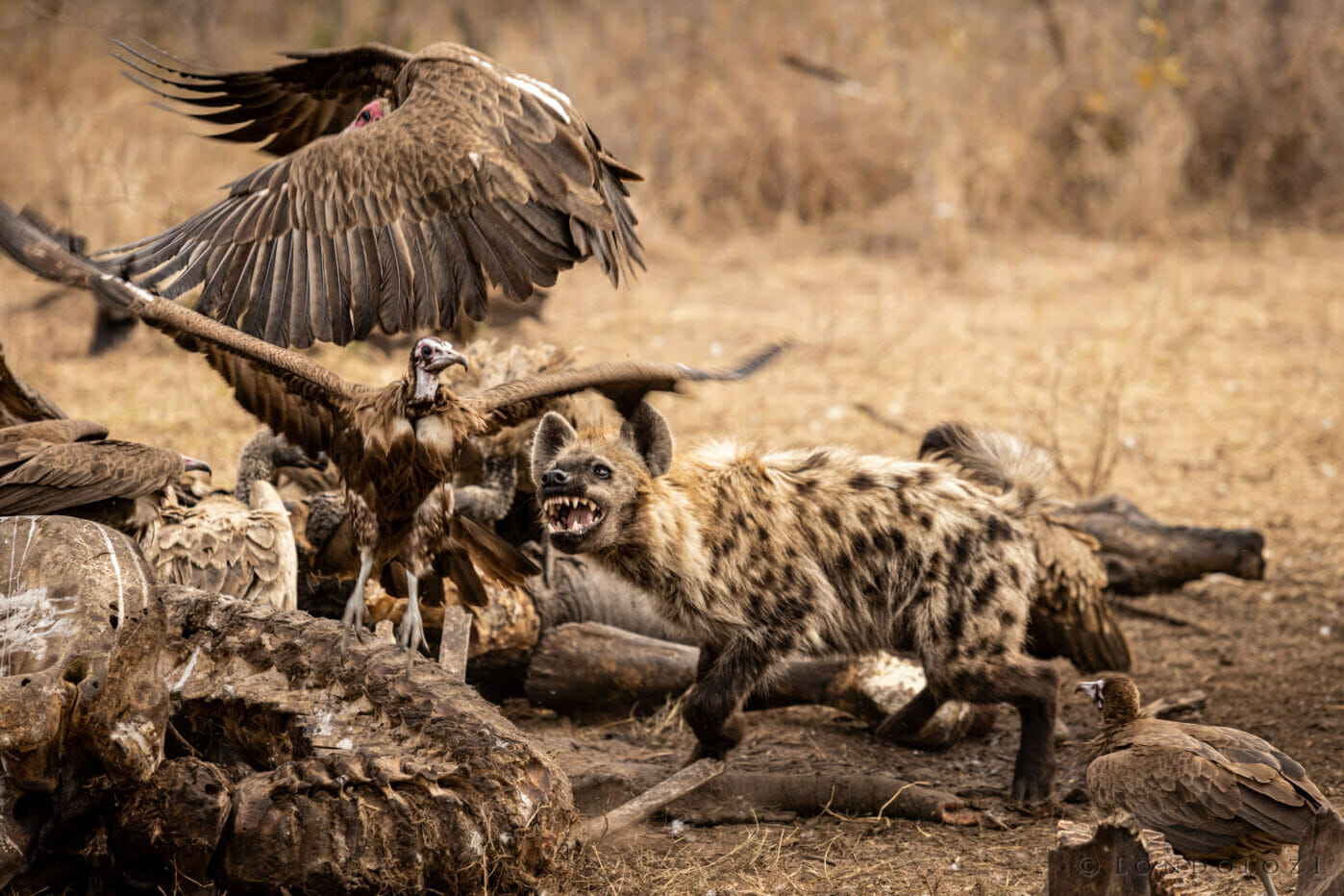Occasionally at Londolozi, we witness the larger herbivores succumbing to injury or old age, inevitably becoming a source of nourishment for a wide variety of scavengers and predators. In one such instance, a hippo bull was found near the banks of the Sand River a few weeks back. It had passed away naturally, likely due to a fight with one of the dominant males that occupied the river’s pools.

Two hippo bulls engage in a fight over a pool in the Sand River. These fights can sometimes lead to death.
Though it’s sad to see such a massive beast lifeless, there’s a positive to it: the scavengers and predators that feed on the fresh meat will be nourished and rest easier. A large hippo bull like this offers us, as viewers, several days of incredible sightings as the remains gradually fade from a massive animal into little more than a few scattered bones.
It always begins with the vultures in the heat of the day. As the wind thermals start to rise, the vultures leave their roosting spots. Sometimes, only one may spot the vacant carcass, honing in on it to secure the prime feeding position. As it dives to the ground, the other vultures in the vicinity pick up on its behaviour and follow suit, descending rapidly. Before we knew it, over 200 vultures, representing all five species that can be seen here in the Lowveld, had crowded around their “magical” find.
As the sun began to set and the afternoon cooled off, hyenas caught the scent of the hippo carcass. Drawn by the promise of an easy meal, many of these powerful scavengers arrived, creating an absolute feeding frenzy. At one stage, we managed to count 25 hyenas just before the sun had completely set. While the sun was still up, the hyenas and vultures fed side by side, semi-tolerating each other as they tried to consume as much food as possible. With nightfall approaching (when vultures stop feeding), there was a sense of urgency in the air. For the hyenas, however, the looming darkness brought a different concern: the possibility of lions arriving and disrupting their chance to fill their stomachs.

Usually at big carcasses, hyenas and vultures will tolerate each other (to an extent). With lots of food available there’s sometimes no need to fight over it.
To make things just a little more special, it was the night of the full moon. As the vultures swooped upwards to begin digesting their meals, a few of them perched in a dead leadwood tree, silhouetted against the shimmering horizon. As the sky darkened and the moon began to rise, casting its glow through the dust and golden haze in the distance, we positioned the vehicle for a breathtaking view. It was a scene that felt almost unbelievable in its beauty.
The next morning, we decided to return to the site to see what had transpired overnight. Upon arrival, we found members of the Ntsevu Pride feeding on what little remained of the hippo carcass. The hyenas had completely vanished, while some vultures still tugged at the remaining scraps. The lions didn’t stay long, as most of the meat had been devoured by the hyenas throughout the night. However, one lioness wasn’t content with sacrificing even the last scraps to the scavenging vultures. We watched as she repeatedly rushed at the vultures, fiercely defending what was left of “her” meal, chasing them away from the remaining bones and skin.

Notice the Ntsevu lioness in the background waiting to rush in and chase the vultures off the hippo.
View this post on Instagram
The two days of incredible interactions among these wild animals around the carcass were truly something special to experience. As mentioned earlier, while it’s sad to see one animal lose its life, it brings life and a few extra days of happiness to so many others. The lions and hyenas get to feed their cubs, and the vultures can nourish their chicks. The circle of life out here in the wild is truly amazing.




















The vulture photo was my favorite of TWIP. Seeing the other one is just as amazing as the first. Both should be entered into some contest!! Bound to win. Again great photo’s Dan.
Dan, really liked the silhouette photo of the vultures in the leadwood tree. Thanks for sharing it again.
Great photos, Dan. And lots of competition going on round that carcass.
It is sad to see such a huge animal being killed by one of its own. But the circle of life must proceed. One’s death is another one’s meal, and as you say Dan it is a good meal to feed the vultures and their chick’s, hyenas and their cubs.
Terrific photos and update to the hippo carcass report, this time focusing on the other scavengers that benefited from its death. One of my favorite images is that of the Ntsevu female chasing off the vultures in addition to the flashing teeth of the hyena as it tries to chase off the vultures. Your blog further punctuates the fact that a life lost in the wild, however it occurs, sustains the lives of many others. It’s sad but necessary to the circle of life.
I love the second shot of the vultures in this post. There’s one vulture in the light, the sign of Life, and there’s a massing horde of vultures in the darkness, the forces of Death. Or Death’s cleanup crew, anyway! It encapsulates what you’ve also expressed in the story, Dan. On a side note, I recall a hippo carcass at the dam outside Lower Sabie … the stench when the wind turned in your direction was quite probably the worst smell I’ve ever experienced!